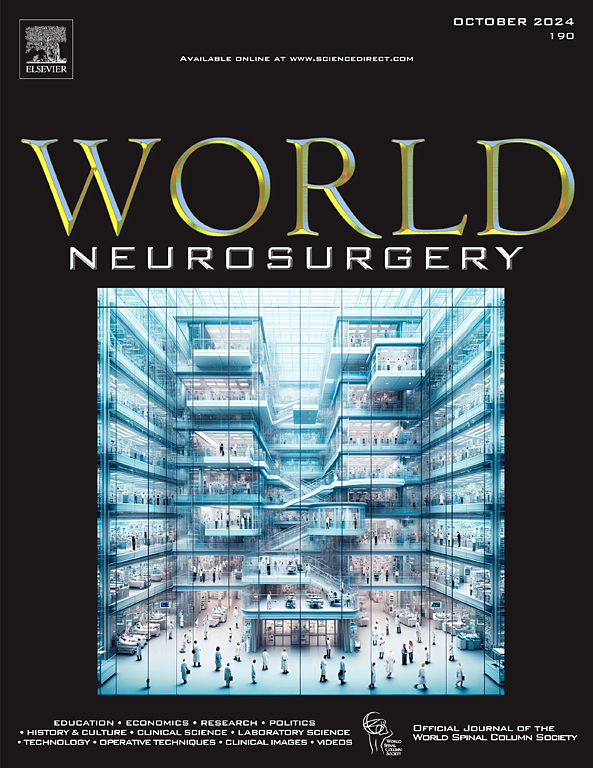脊髓肌肉萎缩症患者脊柱侧弯手术期间的术中神经电生理监测。
IF 1.9
4区 医学
Q3 CLINICAL NEUROLOGY
引用次数: 0
摘要
研究设计:回顾性研究目的:评价中国大陆脊髓性肌萎缩患者脊柱侧凸手术期间监测数据和结果的疗效和特点。方法:分析2019年7月至2022年8月在我院脊柱侧凸中心连续行脊柱畸形手术的27例脊髓性肌萎缩症患者和59例青少年特发性脊柱侧凸(AIS)患者的体感诱发电位(SSEP)、运动诱发电位(MEP)记录。结果:所有SMA和AIS患者均可诱导SSEP。肌萎缩侧索硬化症患者的潜伏期值延长,幅度明显降低。SMA和AIS患者上肢短拇外展肌(APB)的MEP监测相似,尽管SMA患者的激发率和振幅低于AIS患者,但下肢内收肌(ADD)、股四头肌(QUA)、胫骨前肌(TA)、外展幻肌(AH)的联合记录是必要和有效的。结论:在SMA患者脊柱侧凸手术矫正过程中,常规的多模态术中神经生理监测(IONM)脊髓感觉和运动功能是可行和安全的,特别是当AH肌联合ADD、QUA和TA肌记录mep时。本文章由计算机程序翻译,如有差异,请以英文原文为准。
Intraoperative neurophysiological monitoring during scoliosis surgery in patients with spinal muscular atrophy
Study design
A retrospective study
Objective
To evaluate the efficacy and characteristics of monitoring data and outcomes during scoliosis surgery in patients with spinal muscular atrophy from Mainland China.
Method
We analyzed somatosensory evoked potential (SSEP), motor evoked potential (MEP) records of 27 consecutive patients with spinal muscular atrophy and 59 patients with adolescent idiopathic scoliosis (AIS), who underwent spinal deformity surgery in our scoliosis center from July 2019 through August 2022.
Results
SSEP were elicitable in all SMA and AIS patients. The values of latencies prolonged and the amplitudes were significantly lower in SMA patients. MEP monitoring is similar in abductor pollicis brevis (APB) muscles in upper extremities of both SMA and AIS patients and combined recording from the adductor (ADD), quadriceps (QUA), tibialis anterior (TA), abductor hallucis (AH) muscles in lower extremities was necessary and effective although the elicitation rate and amplitudes in SMA patients was lower than those in AIS patients.
Conclusion
Routine multimodality intraoperative neurophysiological monitoring (IONM) of spinal cord sensory and motor function was feasible and safe during surgical correction of scoliosis in patients with SMA, particularly when MEPs were recorded from the AH muscle combined with ADD, QUA and TA muscles.
求助全文
通过发布文献求助,成功后即可免费获取论文全文。
去求助
来源期刊

World neurosurgery
CLINICAL NEUROLOGY-SURGERY
CiteScore
3.90
自引率
15.00%
发文量
1765
审稿时长
47 days
期刊介绍:
World Neurosurgery has an open access mirror journal World Neurosurgery: X, sharing the same aims and scope, editorial team, submission system and rigorous peer review.
The journal''s mission is to:
-To provide a first-class international forum and a 2-way conduit for dialogue that is relevant to neurosurgeons and providers who care for neurosurgery patients. The categories of the exchanged information include clinical and basic science, as well as global information that provide social, political, educational, economic, cultural or societal insights and knowledge that are of significance and relevance to worldwide neurosurgery patient care.
-To act as a primary intellectual catalyst for the stimulation of creativity, the creation of new knowledge, and the enhancement of quality neurosurgical care worldwide.
-To provide a forum for communication that enriches the lives of all neurosurgeons and their colleagues; and, in so doing, enriches the lives of their patients.
Topics to be addressed in World Neurosurgery include: EDUCATION, ECONOMICS, RESEARCH, POLITICS, HISTORY, CULTURE, CLINICAL SCIENCE, LABORATORY SCIENCE, TECHNOLOGY, OPERATIVE TECHNIQUES, CLINICAL IMAGES, VIDEOS
 求助内容:
求助内容: 应助结果提醒方式:
应助结果提醒方式:


